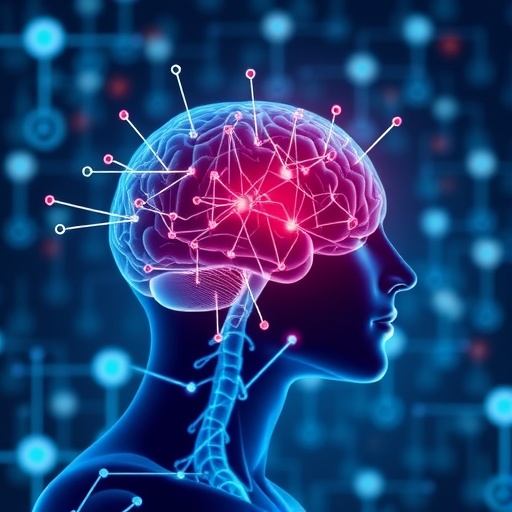
In a groundbreaking study published in the highly regarded Military Medicine Research journal, a team of researchers led by Z.P. Dai, Q. Wen, and P. Wu have ventured into the complex realm of γ neuromodulations to uncover potentially transformative biomarkers for neurological and psychiatric disorders. Their work comes at a time when understanding the intricate interplay between neural mechanisms and behavioral outcomes is more crucial than ever. With the prevalence of mental health challenges on the rise globally, pinpointing specific biomarkers could pave the way for early diagnosis and more targeted therapies.
The focal point of the research is the modulation of neural activity in the gamma frequency range, which has been associated with a variety of cognitive functions such as perception, attention, and memory. The γ band oscillations represent an essential aspect of brain signaling that is thought to impact how individuals process information and respond to their environment. By honing in on this frequency band, the authors aim to identify reliable biomarkers that can provide insights into the pathophysiology of various neurological and psychiatric disorders.
As the scientists delve deeper into the mechanisms of γ neuromodulation, they combine sophisticated neuroimaging techniques and electrophysiological methods. This multidimensional approach offers a comprehensive understanding of how γ oscillations might contribute to neural circuitry and behavioral manifestations in conditions like schizophrenia, depression, and post-traumatic stress disorder (PTSD). The research teamâs innovative methods hold the potential not only to reveal previously unknown connections but also to establish new paradigms in how we view brain function.
Moreover, the study emphasizes the importance of the brainâs neuroplasticityâits ability to reorganize itself by forming new neural connections throughout life. This adaptability may provide a therapeutic window for interventions aimed at modifying γ oscillatory activity. By leveraging techniques such as transcranial magnetic stimulation (TMS) or pharmacological agents designed to enhance γ activity, the researchers speculate that there could be novel avenues for treatment that are more finely tuned to the individual’s unique neural architecture.
Through their analysis, Dai and colleagues establish that specific γ neuromodulations correlate with distinct behavioral outcomes, suggesting a direct link between neural oscillatory patterns and clinical symptoms experienced by individuals with neurological and psychiatric disorders. This connection is particularly significant in clinical settings, where identifying biomarkers could facilitate quicker and more accurate assessments of patient needs. Understanding these patterns not only aids in diagnosis but also allows for monitoring the efficacy of therapeutic interventions over time.
Perhaps one of the most compelling aspects of this research is its potential to address the stigma often associated with mental health disorders. By shifting the narrative from a purely psychological viewpoint to a neurobiological one, the team hopes to promote greater acceptance and understanding of these conditions. As biomarkers become more established, they could increase awareness among healthcare providers and the general public about the biological underpinnings of mental health issues, fostering a more compassionate approach to treatment.
The implications of successfully identifying these biomarkers extend beyond the realm of diagnosis. For researchers and pharmaceutical companies alike, establishing reliable indicators of neural dysfunction can facilitate the development of targeted therapies, reducing the time and costs associated with drug discovery. These advancements could also lead to a new wave of personalized medicine, where treatments are tailored based on an individual’s specific biomarker profile, optimizing the effectiveness and minimizing side effects.
While the implications of this study are vast, the researchers also acknowledge the challenges that lie ahead. The complexity of the human brain, with its myriad connections and functions, means that future studies will likely need to encompass a wide range of methodologies and interdisciplinary approaches. The trajectory of this research will rely not only on further validation of the identified biomarkers but also on multidisciplinary collaboration among neuroscientists, clinicians, and psychologists.
Moreover, ethical considerations surrounding the use of biomarkers in mental health must be addressed. As promising as these advancements are, they come with responsibilities regarding privacy, consent, and the potential for misinterpretation of results. As the scientific community moves forward, it will be vital to ensure that this research supports a holistic understanding of mental health and does not lead to reductive or deterministic views of human behavior.
In conclusion, the pioneering work by Dai, Wen, and Wu signifies a leap forward in our quest to understand and treat neurological and psychiatric disorders. By pinpointing the significance of γ neuromodulations as biomarkers, they illuminate a path toward not only better diagnostics but also innovative therapeutic strategies. As the field continues to evolve, the hope is that this research will inspire further exploration into the dynamic relationship between brain function and mental health, ultimately leading to improved outcomes for those affected by these complex disorders.
The groundbreaking insights from this study serve as a reminder of the potential that lies within scientific exploration. By questioning existing paradigms and embracing new methodologies, researchers can forge new pathways toward understanding the human experience. In a landscape where mental health is often overshadowed by stigma and misunderstanding, it is imperative that scientific advancements continue to illuminate the biological foundations of these conditions, advocating for a more empathetic and informed approach to mental health care.
As the conversation around mental health evolves, studies like these highlight the importance of ongoing research and public engagement. With a commitment to unraveling the complexities of the brain, scientists are not only opening doors to new knowledge but also nurturing a culture of awareness and support that can drive significant societal change. Thus, as we reflect on the findings of Dai et al., we are reminded that the journey toward understanding the mind is far from complete, and it is one that beckons us all to participate in.
Subject of Research: γ neuromodulations and their role as biomarkers for neurological and psychiatric disorders.
Article Title: γ neuromodulations: unraveling biomarkers for neurological and psychiatric disorders.
Article References:
Dai, ZP., Wen, Q., Wu, P. et al. γ neuromodulations: unraveling biomarkers for neurological and psychiatric disorders. Military Med Res 12, 32 (2025). https://doi.org/10.1186/s40779-025-00619-x
Image Credits: AI Generated
DOI:
Keywords: γ neuromodulations, biomarkers, neurological disorders, psychiatric disorders, neuroplasticity, brain function, mental health, personalized medicine.
Tags: cognitive function and brain signalingearly diagnosis of mental health issueselectrophysiological methods in neurosciencegamma frequency brain activitymental health challenges and solutionsneural mechanisms and behaviorneuroimaging techniques in researchneurological disorder researchneuromodulation biomarkers for mental healthpsychiatric disorder biomarkerstargeted therapies for mental healthtransformative approaches in psychiatric research



